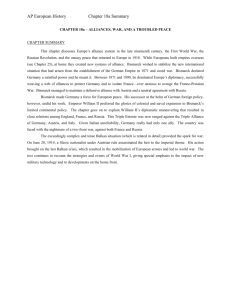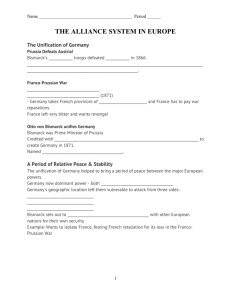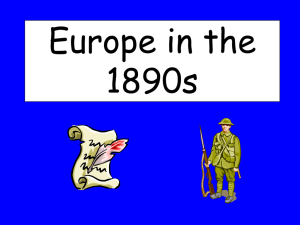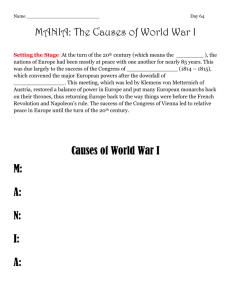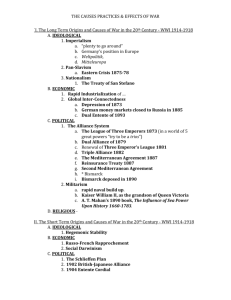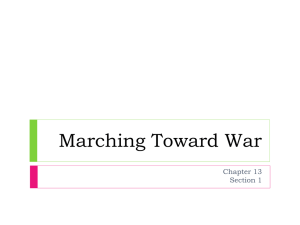File
advertisement
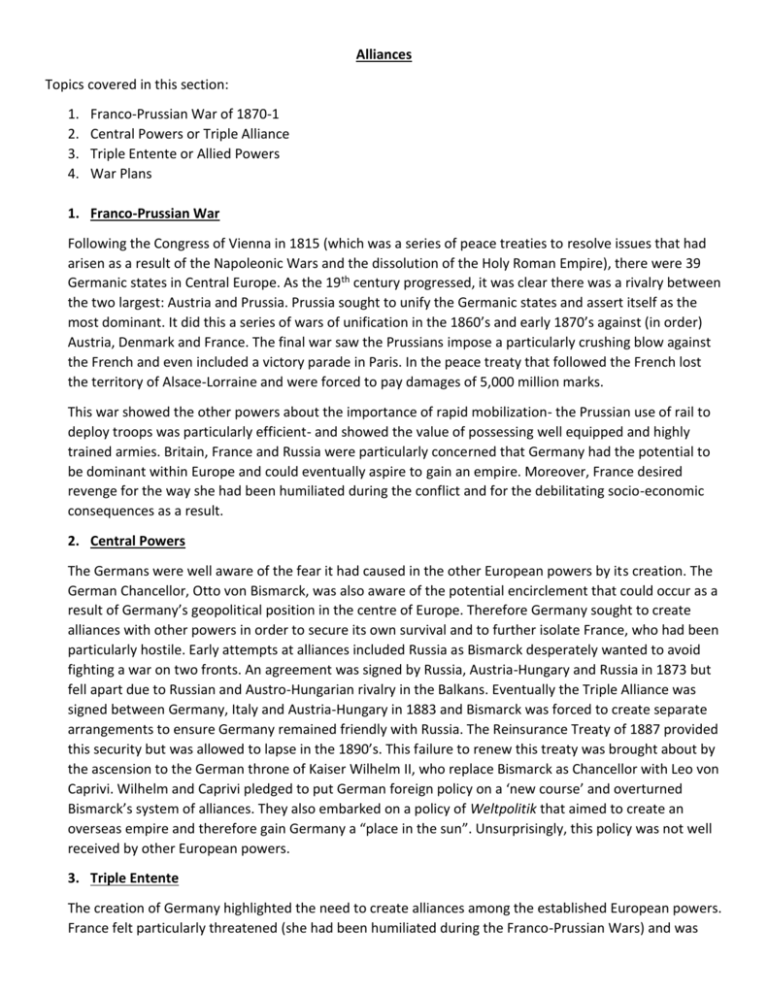
Alliances Topics covered in this section: 1. 2. 3. 4. Franco-Prussian War of 1870-1 Central Powers or Triple Alliance Triple Entente or Allied Powers War Plans 1. Franco-Prussian War Following the Congress of Vienna in 1815 (which was a series of peace treaties to resolve issues that had arisen as a result of the Napoleonic Wars and the dissolution of the Holy Roman Empire), there were 39 Germanic states in Central Europe. As the 19th century progressed, it was clear there was a rivalry between the two largest: Austria and Prussia. Prussia sought to unify the Germanic states and assert itself as the most dominant. It did this a series of wars of unification in the 1860’s and early 1870’s against (in order) Austria, Denmark and France. The final war saw the Prussians impose a particularly crushing blow against the French and even included a victory parade in Paris. In the peace treaty that followed the French lost the territory of Alsace-Lorraine and were forced to pay damages of 5,000 million marks. This war showed the other powers about the importance of rapid mobilization- the Prussian use of rail to deploy troops was particularly efficient- and showed the value of possessing well equipped and highly trained armies. Britain, France and Russia were particularly concerned that Germany had the potential to be dominant within Europe and could eventually aspire to gain an empire. Moreover, France desired revenge for the way she had been humiliated during the conflict and for the debilitating socio-economic consequences as a result. 2. Central Powers The Germans were well aware of the fear it had caused in the other European powers by its creation. The German Chancellor, Otto von Bismarck, was also aware of the potential encirclement that could occur as a result of Germany’s geopolitical position in the centre of Europe. Therefore Germany sought to create alliances with other powers in order to secure its own survival and to further isolate France, who had been particularly hostile. Early attempts at alliances included Russia as Bismarck desperately wanted to avoid fighting a war on two fronts. An agreement was signed by Russia, Austria-Hungary and Russia in 1873 but fell apart due to Russian and Austro-Hungarian rivalry in the Balkans. Eventually the Triple Alliance was signed between Germany, Italy and Austria-Hungary in 1883 and Bismarck was forced to create separate arrangements to ensure Germany remained friendly with Russia. The Reinsurance Treaty of 1887 provided this security but was allowed to lapse in the 1890’s. This failure to renew this treaty was brought about by the ascension to the German throne of Kaiser Wilhelm II, who replace Bismarck as Chancellor with Leo von Caprivi. Wilhelm and Caprivi pledged to put German foreign policy on a ‘new course’ and overturned Bismarck’s system of alliances. They also embarked on a policy of Weltpolitik that aimed to create an overseas empire and therefore gain Germany a “place in the sun”. Unsurprisingly, this policy was not well received by other European powers. 3. Triple Entente The creation of Germany highlighted the need to create alliances among the established European powers. France felt particularly threatened (she had been humiliated during the Franco-Prussian Wars) and was then left isolated by Bismarck’s carefully nurtured web of alliances. France’s chance to form an alliance came with Bismarck’s and Caprivi’s ‘new course’ which allowed the Reinsurance Treaty with Russia to expire. France seized upon this and signed the Franco-Russian alliance in 1894. This not only provided European security, but also co-operation on imperial matters- essentially forming an anti-British alliance. Although Britain had remained in ‘splendid isolation’ for much of the 19 th century, it too was feeling threatened by Germany. Despite clashing with the French in Africa and the Russians in Persia and the Far East, tensions were put aside to sign the Entente Cordial with France in 1904 and the Anglo-Russian Treaty of 1907. As with the Franco-Russian alliance, these agreements provided immediate security and imperial co-operation. 4. War Plans The creation of two separate alliance systems in Europe further contributed to German fear of encirclement and fighting a war on two fronts. Therefore, Germany began formulating war plans to prevent this nightmare from becoming a reality. One such plan was the Schlieffen plan (created by Count Alfred von Schlieffen in 1905). This aimed for a rapid mobilization of German troops and a quick sweeping advance through Belgium in order to invade and occupy France within 6 weeks. This would then enable Germany to turn around in order to fight a longer war against Russia, who many felt would take longer to mobilize due to the vast amount of territory it possessed. The Schlieffen plan was extremely aggressive and pro-active because it depended on rapid mobilization as soon as it was clear that other countries were mobilizing their troops (in other words, before formal declaration of war). The French were also busy making war plans- one such being plan XVII. This called for a quick advance into German territory by concentrating troops alongside Alsace-Lorraine.

